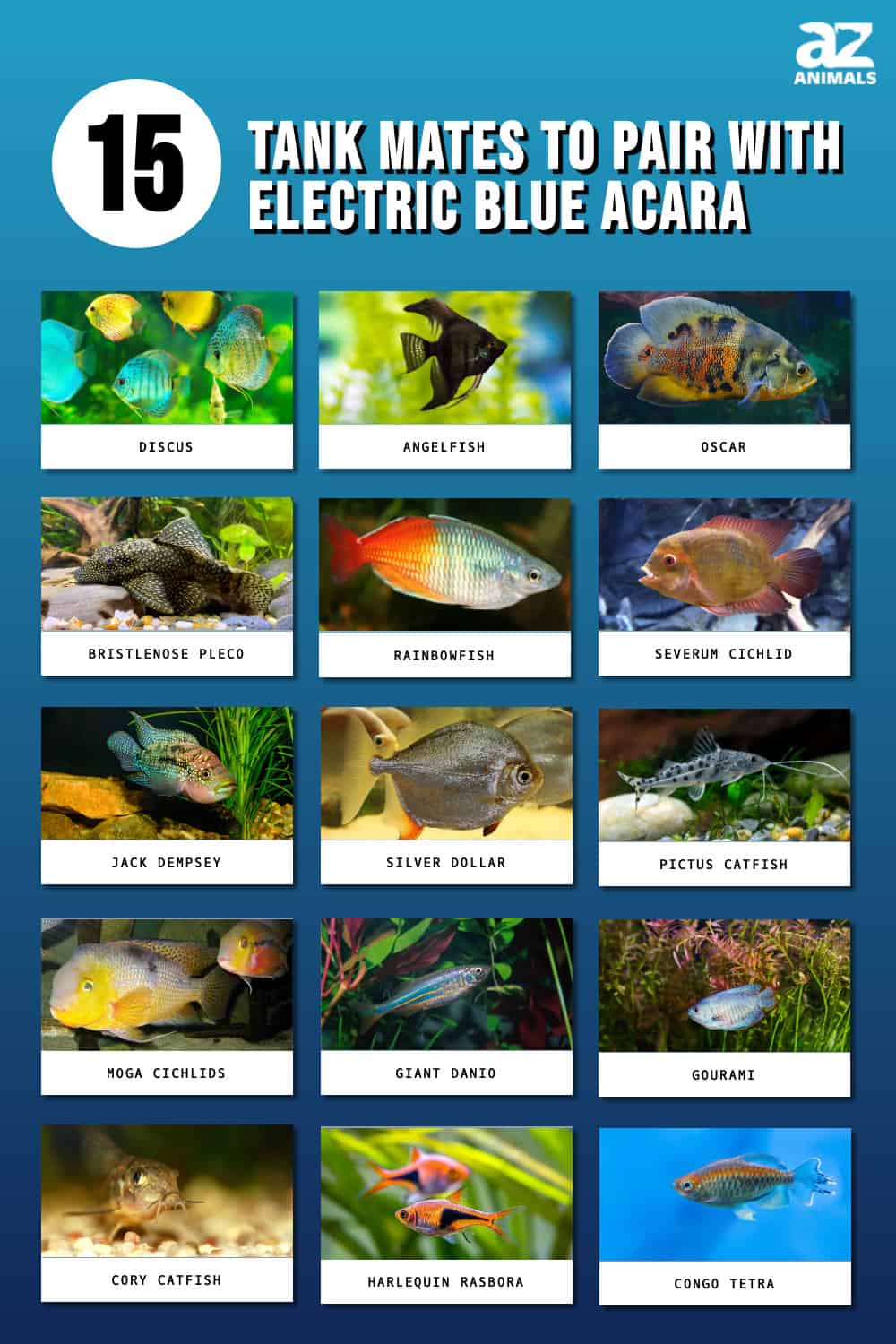
The electric blue acara (Andinoacara pulcher), also known simply as the blue acara, is a freshwater fish hailing from the slow-moving rivers and streams of Peru and Brazil. These fish have become popular aquarium fish because of their stunning electric blue color and calm nature.
Electric blue acaras are friendly with other peaceful fish, making them an excellent choice for community aquariums. But we must stress how important it is to pick the right tank mates for them to keep all your fish happy and comfortable.
In this article, we will talk about 15 different fish that make good tank mates for electric blue acaras. We will also dive into how to take care of each of these companion fish.
1. Discus (Symphysodon)

Discus fish are very flat and elongated, fiving them their common name.
©Nitr/Shutterstock.com
Native to the Amazon River basin in South America, discus fish are a popular aquarium fish that make great tank mates for electric blue acara. These fish possess a distinctive, round, and compressed body shape that resembles a disc, which gives them their name. They come in a variety of color variations, such as red, blue, green, and brown, and can grow to 5-7 inches in length.
Discus fish are shy and peaceful in demeanor and tend to only socialize with their own species. A tank size of at least 50-75 gallons is recommended for a small group, as they require a spacious aquarium with ample horizontal swimming space. You should also keep the water temperature between 82 and 86°F.
Discus fishes make great tankmates for the electric blue acara as they both are peaceful species and come from the same region in the world. This means both species require similar water temperatures and salinity. The discus fish also comes in various colors, so they provide a beautiful contrast from the electric blue acara’s coloring.
2. Angelfish (Pterophyllum)

There are many types of angelfish, both saltwater and freshwater. Only freshwater varieties should be paired with electric blue acara.
©Saad315/Shutterstock.com
Angelfish are another fish species from the tropical areas of South America that fish enthusiasts often put in their freshwater aquariums. With a triangular body and elongated fins, they can grow to about 6-10 inches in height. Angelfish are best kept in pairs and require a tank size of at least 30 gallons. You should keep your angelfish at a water temperature between 75 to 82°F. Angelfish are unique, and you can find them in a variety of vibrant colors that compliment electric blue acara. Electric blue acara and angelfish are suitable tank mates as they both occupy different levels of the aquarium. Angelfish prefer higher levels of the aquarium, while electric blue acara typically occupy the middle and lower zones.
3. Oscar (Astronotus ocellatus)

Growing to a very large size, Oscar fish are a popular freshwater aquarium fish.
©Boris Bulychev/Shutterstock.com
Oscar fish may not be the most beautiful species in the world, but they are certainly an interesting fish that does well in aquariums. This species is known for its impressive size, growing up to a foot in length! These fish originate from the Amazon River basin and thrive in similar conditions to electric blue acara, making them good tank mates.
Oscars come in various colors, such as orange, red, and dark brown. Oscars can occasionally display territorial behavior, but they are generally docile around their tank mates.
As these fish are from the tropics, we don’t recommend letting their tank drop below 75 degrees. Being large fish, they also need a sizeable tank to give them ample room to swim around and explore.
Fun fact: Oscars are a highly intelligent fish species and can even be trained to do tricks!
4. Bristlenose Pleco (Ancistrus Cirrhosus)
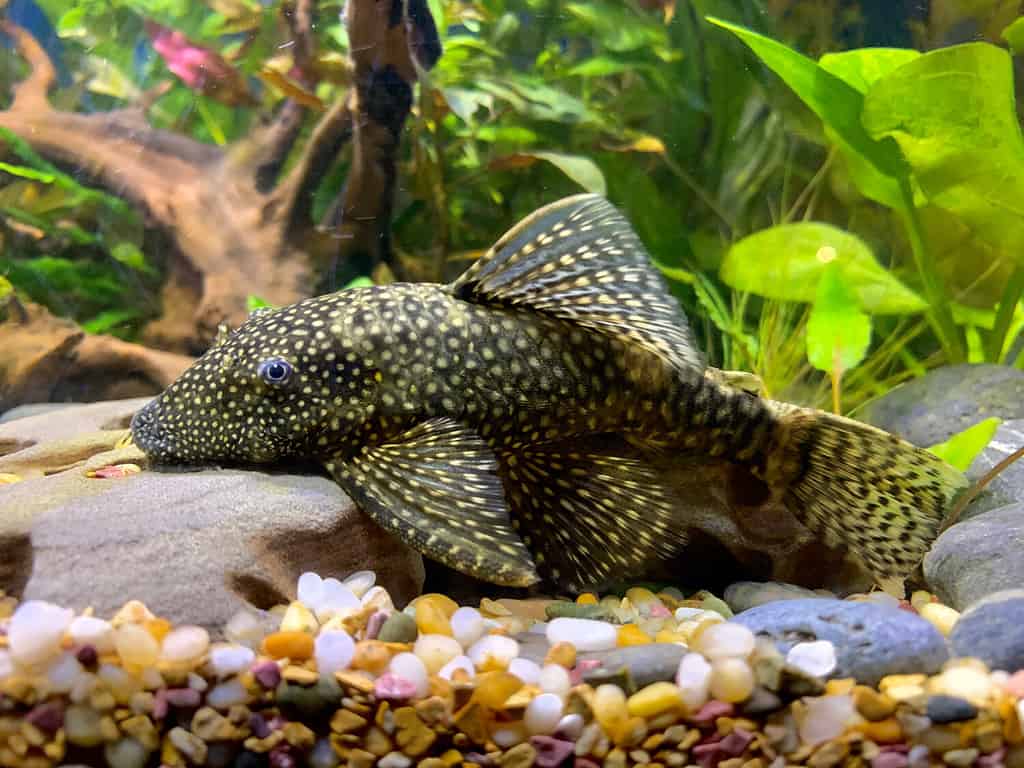
Only male bristlenos pleco grow long spiky bristles on their noses.
©TTONN/Shutterstock.com
The bristlenose pleco is a small and extremely unique-looking freshwater fish that could be a tank mate for an electric blue acara. These fish only grow to around 5 or 6 inches and have a distinctive appearance of armored body plates, and the males of the species have spiky growths on their snouts. Bristlenose plecos coexist harmoniously with various other fish species. To create a suitable habitat for these fish, we recommend using a tank with at least 20 gallons and a water temperature range of 72 to 82°F.
Pairing bristlenose plecos with electric blue acaras is a great choice because they are both calm animals that require similar climates.
5. Rainbowfish (Melanotaeniidae)
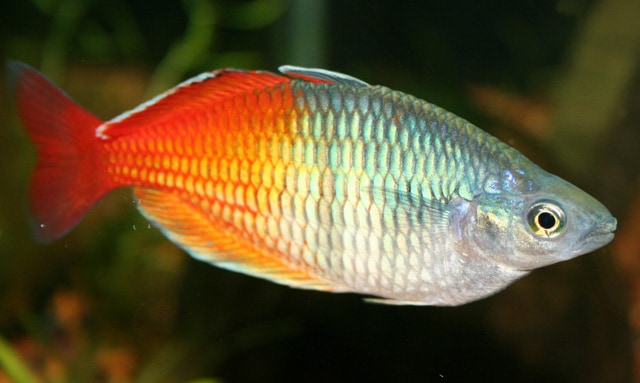
Rainbowfish, native to regions including Australia, Papua New Guinea, and Southeast Asia, add vibrant colors and peaceful companionship to your aquarium.
©Eileen Kortright / CC BY 2.5 – License
As the name of the species suggests, rainbowfish are brightly colored and are a great way to add some color to your aquarium. Rainbowfish are calm-natured and pair well with many other tropical freshwater species. The first fish to not be from the Amazon region, this species is native to areas of Australia, Papua New Guinea, and Southeast Asia. They tend to be very small, only growing to a maximum of 4.7 inches. Rainbowfish are perfect tank mates for electric blue acara and tend to get along well with many non-aggressive species.
Both rainbowfish and electric blue acaras enjoy similar water conditions and have peaceful personalities. What makes rainbowfish special is the way their colors seem to dance in the water, giving your aquarium a vibrant and lively vibe. Fish lovers describe these fish as tiny, living rainbows swimming around, making your underwater world even more enchanting.
6. Severum Cichlid (Heros severus)
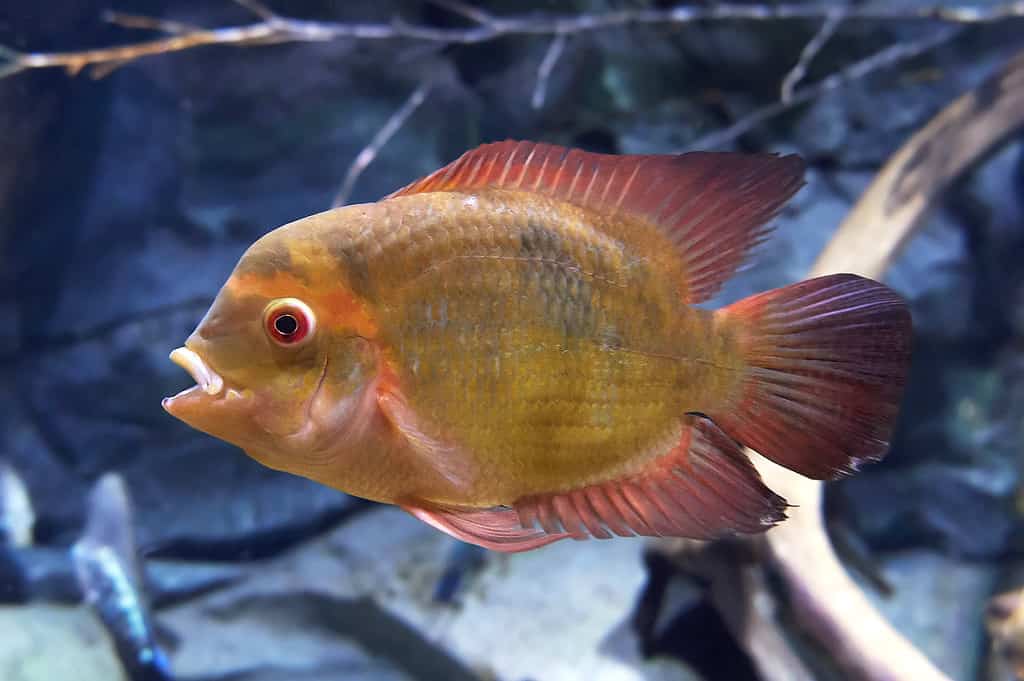
Severum cichlid are tropical freshwater fish that can be found in the wild in South America.
©iStock.com/Denja1
With a distinctive disk-like shape, striking patterns, and friendly nature, the severum cichlid is a popular choice for freshwater aquariums. Like many other potential tank mates for electric blue acara, the severum cichlid originates from South America, particularly the Amazon River basin.
They can grow to about 6 to 8 inches in size, making them a medium-sized addition to your tank. When setting up a tank for them, you will need at least 40 gallons, and be sure to keep the water temperature between 72 to 82°F.
Pairing severum cichlids with electric blue acara creates a harmonious combination of colors and behaviors in your tank, and both fishes share similar preferences for water conditions. The Severum Cichlids are also known for their distinct personality and the way they interact with their surroundings. They are known for their curious and playful nature, often exploring their environment and engaging in interesting behaviors that keep your aquarium dynamic and engaging.
7. Jack Dempsey (Rocio octofasciata)
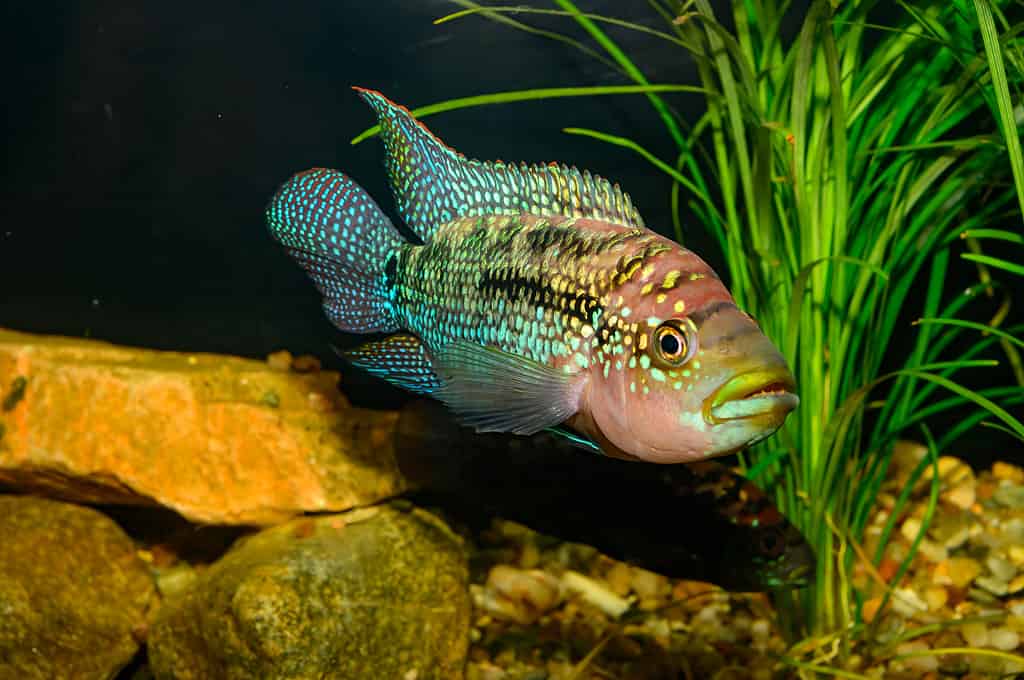
The Jack Dempsey is a species of cichlid that is known to be relatively aggressive and popular in freshwater aquariums.
©Karel Zahradka/Shutterstock.com
The Jack Dempsey fish is native to Central America, from Mexico to Honduras. Its common name refers to its aggressive nature and strong facial features, likened to that of the famous 1920s boxer Jack Dempsey. This fish species is aggressive, so you must be very careful when pairing them with other fish. That said, with the right size tank, Jack Dempsey can be tank mates with an electric blue acara.
They can grow to around 8 to 10 inches in size and will need a pretty sizeable tank, especially if you pair them with other species. Your fish tank should be an absolute minimum of 55 gallons. Otherwise, the fish may be aggressive with the other species.
8. Silver Dollar (Metynnis argenteus)

With a completely flat and silvery body, it is easy to see why the silver dollar fish is called a silver dollar.
©tane-mahuta/ via Getty Images
The silver dollar fish is another fish from South America’s rivers and lakes. They are not as colorful as the other species on this list, but their distinct round shape and silvery color make them an interesting addition to any aquarium. These fish can grow to be about 5 or 6 inches and require at least 30 gallons to thrive in their tank.
They are also known for their calm and friendly temperament, often getting along well with other peaceful fish, including electric blue acara.
What makes silver dollar fish special is their unique shape and the way they glide gracefully through the water. They often move in a school, which adds life and movement to your aquarium.
9. Pictus Catfish (Pimelodus pictus)
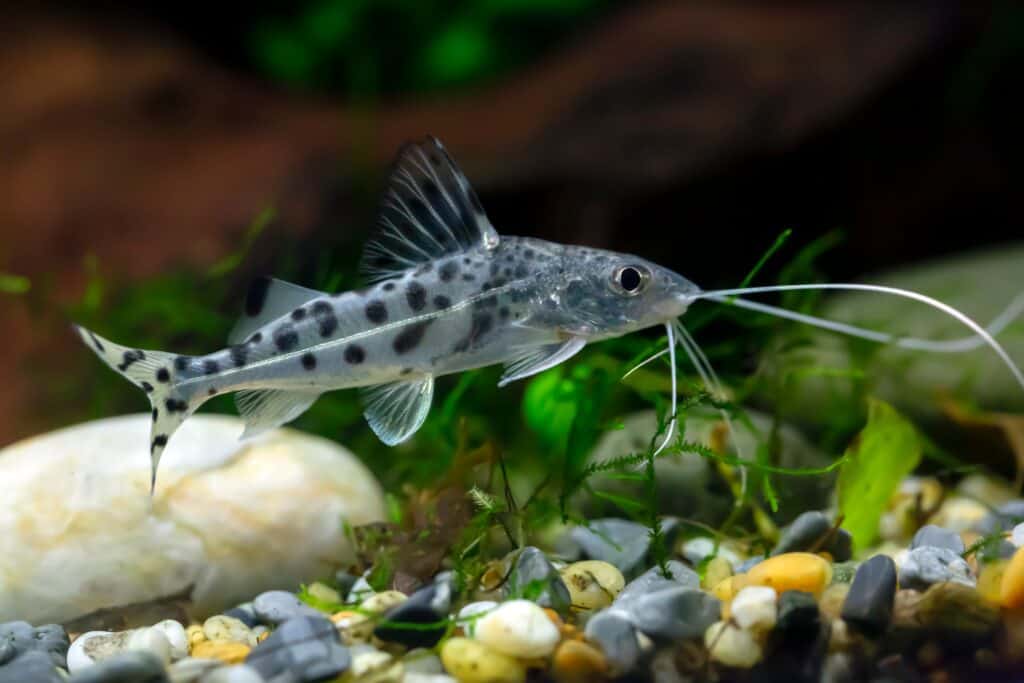
This is one of the smallest
catfish
species, the pictus catfish.
©boban_nz/Shutterstock.com
The pictus catfish is one of the smallest catfish species, growing to a maximum of 5 inches. Due to its small size and interesting appearance, this fish is also one of the most popular catfish used in aquariums. The pictus catfish has long whiskers and an elongated body adorned with distinctive spots. They have a white belly and range in color from pale silver to yellowish-gray.
The Pictus Catfish is undoubtedly a nice touch to any freshwater aquarium. These fish have a lively and inquisitive nature and are relatively easy to care for. While they can be kept alone, it is best to keep a few pictus catfish, as they do best when they are kept together in a group of their species.
10. Moga Cichlids (Hypsophrys nicaraguensis)
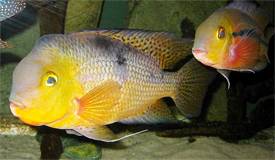
These Moga cichlids grow from eight to ten inches long!
©Tomolyka / CC BY-SA 3.0 – License
Moga cichlids are another intriguing freshwater fish that you could add to a tropical aquarium. These fish hail from the warm freshwater habitats of Central America, particularly Nicaragua and Costa Rica. Growing to a size of around 8 to 10 inches, Moga cichlids are medium-sized fish that add a splash of color to your tank.
Electric blue acara and moga cichlids are great tank mates because they are both calm in demeanor and have similar temperature and habitat requirements. Moga cichlids have a curious and active nature. Their engaging behavior and striking appearance make them a wonderful and distinctive choice for your aquatic community.
11. Giant Danio (Devario aequipinnatus)
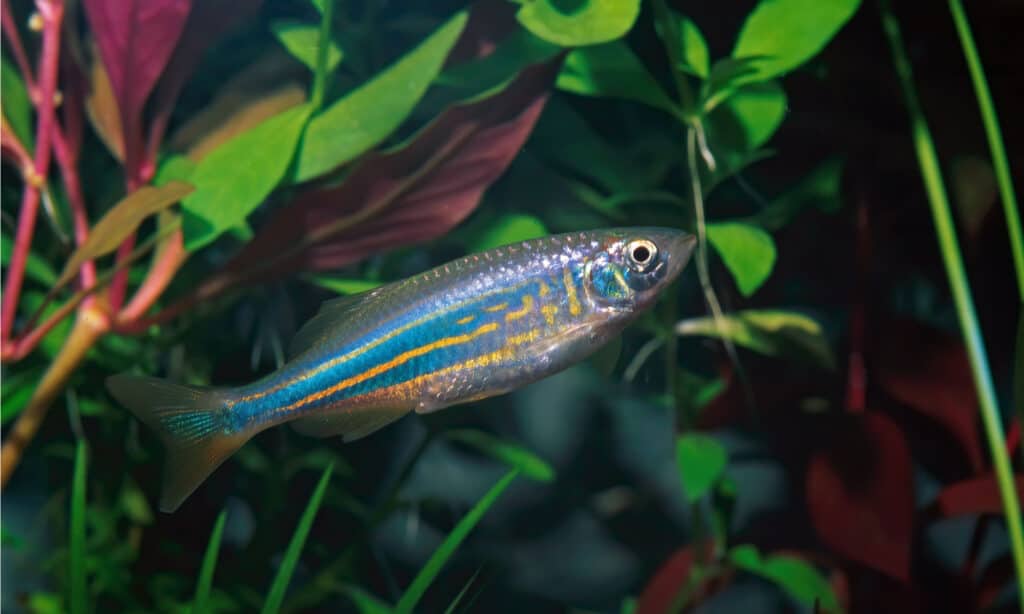
Danios are medium-sized tropical fish that belong to the minnow family.
©Karel Zahradka/Shutterstock.com
Giant danios are small and social fish that come from South Asia, particularly countries like India, Nepal, and Bangladesh. They can grow to be about 4 to 6 inches, and their silvery bodies and distinctive blue stripes make them a real eye-catcher. They often swim around and explore their surroundings. So, despite their small size, they require a larger tank, and a tank of around 30 gallons is an absolute minimum for this species. Additionally, these fish thrive in water that is neither hot nor cold, with an ideal water temperature of around 72-75°F.
Pairing a giant danio with electric blue acaras creates an interesting mix of colors in your tank. These fish often swim in a group, creating a dynamic display that is thrilling to watch. They’re like the energizers of the tank, always on the move and adding a bit of electric energy to your aquarium.
12. Gourami (Osphronemidae)

There are many species of gourami around the world, ranging in size and varying in coloration.
©Yuriy Chertok/Shutterstock.com
Gourami fish, from the Osphronemidae family, are fascinating and popular aquarium fish. This species has an interesting behavior of making bubble nests. Bubble nests are pretty much exactly what they sound like – a nest full of bubbles. Gourami do this to create an oxygen-rich living environment for their eggs.
They come from Asia and can be found in Thailand, India, and Indonesia. Gouramis are a relatively small species, with most reaching only around 3 to 6 inches long. Electric blue acaras and gouramis make good tank mates. In fact, gourami can add a lot of interesting colors to your freshwater tank.
13. Cory Catfish (Corydoras)
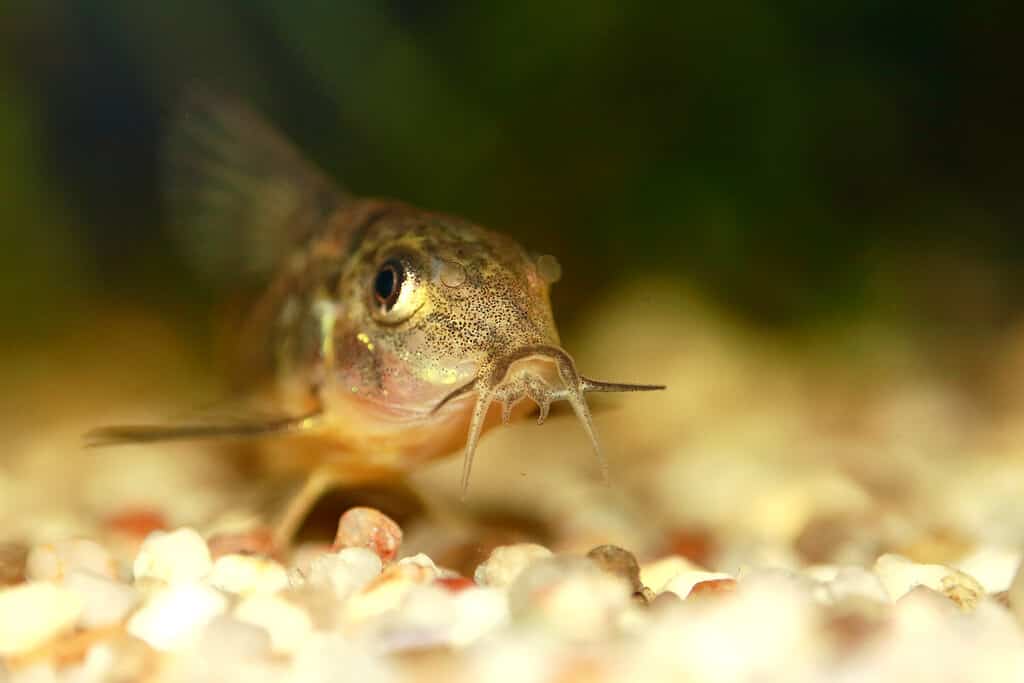
Another teeny tiny freshwater catfish species is the Cory catfish, which barely tops 3 inches in length.
©Kristiana Berzina/Shutterstock.com
Cory catfish, also known as Corydoras, are small and charming fishes that originated in South America. They only grow to about 2-3 inches long and make endearing wiggly movements.
They have a peaceful and social nature and are often seen swimming in groups. For their comfort, you should use a tank of at least 30 gallons, and being from the tropics, they enjoy warm water between 72-78°F. Corydoras come in several different shades, such as bronze, green, brown, and sometimes even black. Some species also have spots, stripes, or other intricate markings on their bodies, adding to their unique and charming appearance. The Cory catfish is a bottom feeder that scavenged along the bottom of the tank, helping to keep it clean. Corydoras and electric blue acaras can get along quite well and make excellent tank mates.
14. Harlequin Rasbora (Trigonostigma heteromorpha)
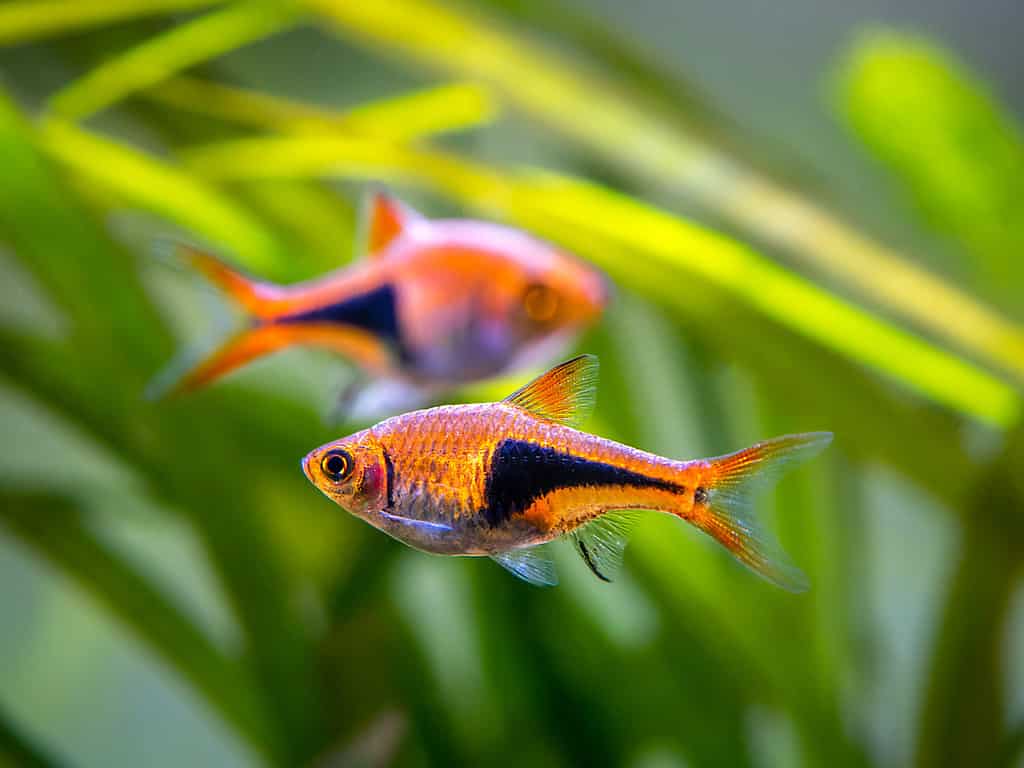
This small colorful fish is a wonderful companion for electric blue acara.
©Joan Carles Juarez/Shutterstock.com
These charming fish originate from Southeast Asia, particularly in places like Malaysia and Thailand. Harlequin Rasboras are tiny fish, growing only to about 1.5 to 2 inches in size. With their striking triangular body shape and distinctive black and orange coloration, they add a vibrant touch to the aquarium. They are known for their peaceful and social temperament, often seen swimming together in schools.
Pairing harlequin rasboras with electric blue acaras creates an appealing mix of behaviors and colors in your tank. Harlequin Rasboras often present a lively schooling behavior with their synchronized, swimming, and playful interactions.
15. Congo Tetra (Phenacogrammus interrupts)
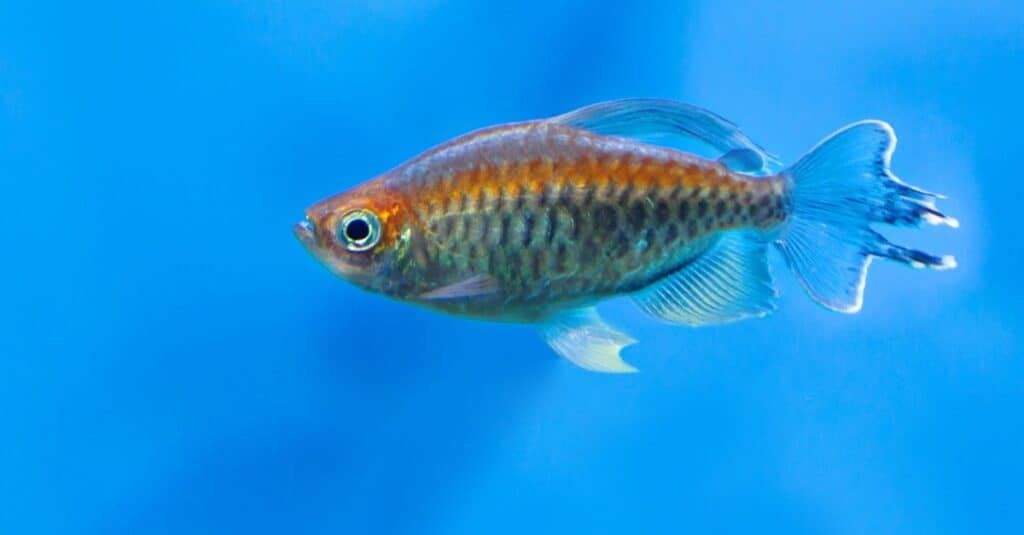
A small tropical fish in the Congo Jungle is the Congo tetra.
©iStock.com/User10095428_393
The Congo tetras are named after their place of origin, the Democratic Republic of Congo in Africa. These tetras have iridescent blue bodies with striking red fins and grow to a size of around 2.5 to 3 inches. Congo tetras are known for their peaceful and sociable nature and are often seen swimming harmoniously in groups. While they are from different sides of the world, Congo tetra and electric blue acaras pair very well together as they are both from freshwater bodies of tropical rainforests.
Congo tetras do best in schools, so it is recommended to add at least 3 or 4 of the species to your tank when you introduce them.
Summary of Ideal Tank Mates to Pair With Electric Blue Acara
| Tank Mate | Scientific Name | |
|---|---|---|
| 1 | Discus | Symphysodon |
| 2 | Angelfish | Pterophyllum |
| 3 | Oscar | Astronotus ocellatus |
| 4 | Bristlenose pleco | Ancistrus cirrhosus |
| 5 | Rainbowfish | Melanotaeniidae |
| 6 | Severum Cichlid | Heros severus |
| 7 | Jack Dempsey | Rocio octofasciata |
| 8 | Silver Dollar | Metynnis argenteus |
| 9 | Pictus Catfish | Pimelodus pictus |
| 10 | Moga cichlids | Hypsophrys nicaraguensis |
| 11 | Giant Danios | Devario aequipinnatus |
| 12 | Gourami | Osphronemidae |
| 13 | Cory Catfish | Corydoras |
| 14 | Harlequin Rasbora | Trigonostigma heteromorpha |
| 15 | Congo Tetra | Phenacogrammus interruptus |
The photo featured at the top of this post is © Saad315/Shutterstock.com
Thank you for reading! Have some feedback for us? Contact the AZ Animals editorial team.






